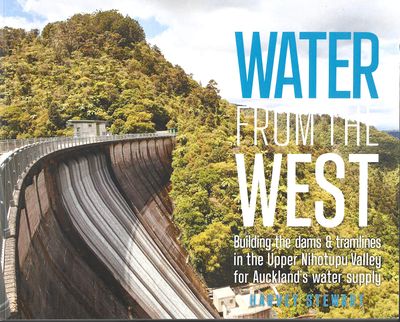Difference between revisions of "Water From the West"
| Line 27: | Line 27: | ||
|{{Pop}} | |{{Pop}} | ||
|} | |} | ||
| − | The author was an engineer for Watercare and its predecessors, working on the structures he writes about. It is not an archaeological exposition as such but goes deeply into the technology of how the | + | The author was an engineer for Watercare and its predecessors, working on the structures he writes about, in their later service. It is not an archaeological exposition as such but goes deeply into the technology of how the dam was built so as to be of great interest to any historian of technology. He notes where there are remains of past structures. |
| + | Stewart puts the need for the Upper Nihotupu supplies in its context of Auckland's water supply needs and covers the intricacies of the contracts put in place for the construction of the dam, not just the main dam construction but the temporary and auxiliary dams, tramways, pipelines and supplies as well. The author had the advantage of talking to some of the identities who had worked on the construction or its early operation and had the benefit of a well-written reminiscence by one of them, reproduced in part here. Unlike rather too many engineers' books of technology history, people are well to the fore. Not just the engineers but the workers themselves. Fatalities were one consequence of the primitive technology of the day - they are acknowledged here. | ||
| − | The book greatly benefits from the services of a professional designer to lift it above many self published efforts. | + | It is profusely illustrated with historical photographs and diagrams, with sufficient modern maps to interpret the myriad of named locations and features. The labeling of the photos is commendably full. |
| + | |||
| + | The book greatly benefits from the services of a professional designer to lift it well above the standard of many self-published efforts. | ||
[[Law Garry|GL]] | [[Law Garry|GL]] | ||
Revision as of 23:35, 9 June 2024
Water From the West
Building the dams and tramlines in the Upper Nihotupu Valley for Auckland's water supply.
Harvey Stewart 2024 Privately Published, Auckland. 112 pp. ISBN 978-0-473-71216-7
There is a review here:
The book can be ordered at:
Blurb
Between 1905 and 1929 the Auckland City Council built dams in the Waitakere, Upper Nihotupu and Upper Huia valleys to provide water for the rapidly growing city. Access to each of these dams was by narrow gauge railway or tramline. This book tells the story of the construction of the tramlines and four dams in the Upper Nihotupu valley, only one of which is still in service today. A unique feature of the Upper Nihotupu dam construction access was a cable hauled incline which lifted the supply wagons 127m over a distance of 575m. The personal memoirs of one of the incline workers are included.
Review
This is a POP page.
|
The author was an engineer for Watercare and its predecessors, working on the structures he writes about, in their later service. It is not an archaeological exposition as such but goes deeply into the technology of how the dam was built so as to be of great interest to any historian of technology. He notes where there are remains of past structures.
Stewart puts the need for the Upper Nihotupu supplies in its context of Auckland's water supply needs and covers the intricacies of the contracts put in place for the construction of the dam, not just the main dam construction but the temporary and auxiliary dams, tramways, pipelines and supplies as well. The author had the advantage of talking to some of the identities who had worked on the construction or its early operation and had the benefit of a well-written reminiscence by one of them, reproduced in part here. Unlike rather too many engineers' books of technology history, people are well to the fore. Not just the engineers but the workers themselves. Fatalities were one consequence of the primitive technology of the day - they are acknowledged here.
It is profusely illustrated with historical photographs and diagrams, with sufficient modern maps to interpret the myriad of named locations and features. The labeling of the photos is commendably full.
The book greatly benefits from the services of a professional designer to lift it well above the standard of many self-published efforts.
